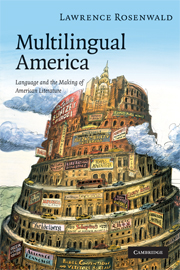Book contents
- Frontmatter
- Contents
- Preface
- Acknowledgments
- Introduction: techniques, methods, theses
- Chapter 1 Cooper's The Last of the Mohicans and the languages of America
- Chapter 2 Alfred Mercier, George W. Cable, and Louisiana French Creole
- Chapter 3 More than an echo, or, English in Yiddish in America
- Chapter 4 “New language fun,” or, on translating multilingual American texts
- Chapter 5 Towards a history of multilingual American literature
- Bibliography
- Index
Introduction: techniques, methods, theses
Published online by Cambridge University Press: 22 September 2009
- Frontmatter
- Contents
- Preface
- Acknowledgments
- Introduction: techniques, methods, theses
- Chapter 1 Cooper's The Last of the Mohicans and the languages of America
- Chapter 2 Alfred Mercier, George W. Cable, and Louisiana French Creole
- Chapter 3 More than an echo, or, English in Yiddish in America
- Chapter 4 “New language fun,” or, on translating multilingual American texts
- Chapter 5 Towards a history of multilingual American literature
- Bibliography
- Index
Summary
TERMS AND CATEGORIES
The Israeli critic Meir Sternberg is not very well known among Americanists, or for that matter among American literary critics generally, but his theoretical work on the representation of what he calls “polylingual discourse” is the best account of it available. So there's no better way to begin investigating the technical aspects of that subject than by setting out some of Sternberg's terms and categories and formulations – beginning with his formulation of the basic issue here, which is that “literary art … finds itself confronted by a formidable mimetic challenge: how to represent the reality of polylingual discourse through a communicative medium which is normally unilingual” (222).
Sternberg first identifies three ways of “circumventing” (223) the challenge. The first, “referential restriction,” involves confining one's literary attention “to the limits of a single, linguistically uniform community whose speech-patterns correspond to those of the implied audience”; Sternberg cites as an example the novels of Jane Austen. The second, “vehicular matching … suits the variation in the representational medium to the variation in the represented object” – that is, whatever languages characters are imagined or identified as speaking are the languages they actually are made to speak. Sternberg's examples, one film and one play, are Jean Renoir's La Grande Illusion and Shaw's Pygmalion. The third, “homogenizing convention,” is in play when an author, having decided to represent a multilingual community, “dismisses the resultant variations in the language presumably spoken by the characters as an irrelevant, if not distracting, representational factor” (224).
Information
- Type
- Chapter
- Information
- Multilingual AmericaLanguage and the Making of American Literature, pp. 1 - 19Publisher: Cambridge University PressPrint publication year: 2008
